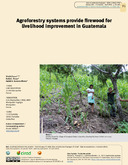Agroforestry systems provide firewood for livelihood improvement in Guatemala
Abstract
Given the context of climate change and
poverty, rural populations are increasingly
faced with the challenges of appropriate
resource management, adequate
food production and improving their
quality of life. Guatemala has to cope
with climate change and poverty while
taking its agricultural production into
account. In this regard, agroforestry systems
have been proposed as an alternative
method of sustainable production.
This article presents a comparison
between conventional cropping systems
and enriched agroforestry systems in
Camotán and Jocotán. The results show
that the enriched agroforestry system
contributed to 65% of the firewood
compared to 7% from the conventional
cropping system. Families using the
conventional cropping system extracted
81% of their firewood from the forest,
while families using the enriched agroforestry
system extracted only 32%. The
firewood produced by the enriched agroforestry
system provided an additional
benefit to women, children and young
people tasked with carrying the bundles,
in that they no longer needed to travel
long distances to supply the household.
Families constructed and adapted empirical
knowledge on tree management into
their cropping systems. The enriched
agroforestry system is thus presented
as a potential solution for meeting the
annual demand for firewood. Land tenure
security influences rural families’ decision
to invest or innovate. Agroforestry
systems play a key role in augmenting
resources and improving quality of life.
Keywords
Publisher
CIRAD, Montpellier (France)
Is part of
Bois et Forêts des Tropiques


